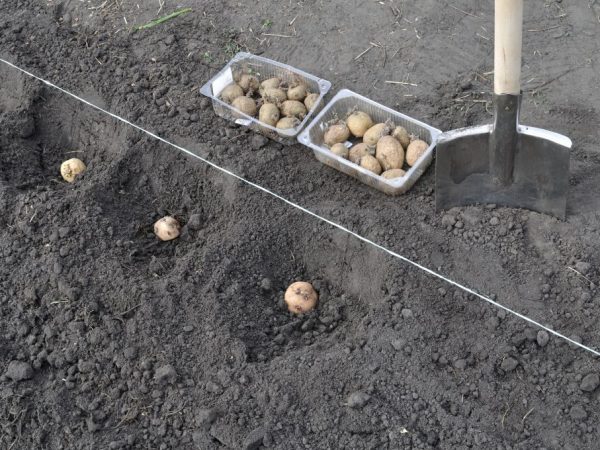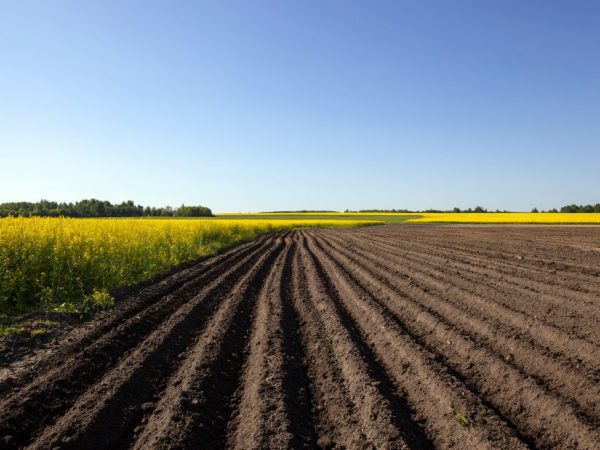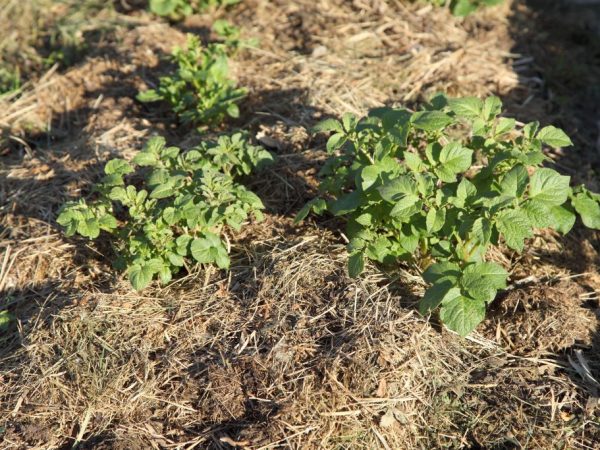The main methods of planting potatoes
The traditional period for planting garden crops is mid-April-early May. Most often, farmers plant potatoes on their plots. Every year, new unusual ways of planting potatoes appear. Consider traditional and non-traditional methods of growing nightshade crops.

The main methods of planting potatoes
Traditional methods
There are 3 methods of planting potatoes as standard:
- smooth;
- trench;
- ridge.
Each of them is suitable for a specific type of soil. Arbitrary choice of planting can significantly reduce the yield in the country. In many ways, the planting method will depend not only on the type of soil, but also on what varieties of potatoes are planned to be grown on the site. There are several general guidelines that should be followed with any planting method:
- the location of the beds from north to south;
- applying a sufficient amount of fertilizer;
- observance of the distance between rows and holes.
Recommended planting distances and depths
All parameters are indicated for tubers of standard size, which do not exceed the size of a hen's egg. When planting planting material of large sizes, the distance must be increased, for smaller ones, it must be reduced. The distances between the rows are left at 60-70 cm in order to have access to the plants and to enable the root system to develop correctly. A distance of 40-50 cm is left between the planting tubers, depending on the variety of potatoes. The method of square-nested marking is used, that is, the holes are arranged in squares.
The planting depth depends entirely on the quality of the soil. On clay soils, potatoes should not be buried more than 5 cm. For heavy and loamy soils, the recommended planting depth is 8-10 cm. On light sandy loam soils, potatoes are buried 12 cm. Large tubers should be planted deeper than small ones. Deviations from standard parameters should not be more than 3-5 cm.
Smooth method
The simplest method of planting potatoes is “under a shovel”. It has been used for a very long time. Usually 2 people are needed to carry out the process. First, markings are made, then holes are dug.
This technique is used on loose, moist enough soils intended for manual planting. Carrying out normal maintenance of the beds with this method of planting, you can get a good harvest. In the future, you need to carry out regular loosening, fertilize the soil and huddle the plants.
Trench method
On light, loose soils, it is recommended to bury the tubers deeper. For this, trenches are made, taking into account the above parameters. Such methods of planting potatoes are not used on wet, dense soils, otherwise there is a risk that the planting material will simply rot.
With such a planting, it is possible to maintain moisture in the soil even under arid climatic conditions.In arid climates, it is recommended to mulch the soil with grass, then it will be possible to retain more moisture in the soil. It is not advisable to hilling, otherwise the roots may burn out.
Ridge method

For heavy soils, the ridge method is suitable
This planting method is used on heavy soils that quickly compact and impede normal air exchange, as well as in areas with a close groundwater table. On the surface of the earth, embankments are made 15 cm high with a distance between rows of 69-81 centimeters.
This method of planting on loams and light soils is inexpedient because the soil is constantly crumbling. In addition, moisture evaporates from the combs very quickly, which complicates the care of potatoes. In practice, this growing method is often used to reduce energy costs when there is a tractor and all the necessary planting equipment.
Unconventional methods
When growing potatoes, as a rule, non-standard planting methods are used to solve certain problems. The quality of the soil deteriorates every year. Constant loosening, application of fertilizers, green manure and chemicals to combat parasites negatively affects fertility.
There are different ways to plant potatoes. Very often, the area of the site or climatic conditions do not allow you to grow many crops in your garden. Today, the no-till method of disembarkation is very popular. Let's consider some of the most interesting and easy-to-use techniques.
Smart beds by Igor Lyadov
Igor Lyadov's method involves two-row landing in boxes. First you need to select a good area, clear it and level the surface. The box can be made from any old boards or other material. The length of the constructed tank can be arbitrary, the width should not exceed 120 cm.
The walls need to be slightly buried in the ground, connected to each other with screws or other material. Lyadov lined the bottom of the resulting box with cardboard, which will prevent the spread of weeds. This is followed by a thin layer of sand. After the sandy base, lay out the coarse remains of plants (tops of legumes, corn, etc.). In addition, you need to take care of protecting the walls of the structure from moisture and insect pests, so it is recommended to treat the surface with waterproof safe paint.
When the walls are prepared and processed, you can continue filling the beds with more succulent grass and vegetable leaves. This is followed by a layer of humus or manure, which is watered with a special herbal infusion. After that, a layer of earth, 10 cm thick, is laid. Such filling of the beds contributes to the continuation of the growing season and helps to accelerate the ripening of the fruits. The joiner's method of growing potatoes involves planting in a two-row way.
Buryat technique
This landing system is suitable for cooler regions. The Buryat planting method is based on planting tubers in pyramidal embankments. A pipe is installed, around which a pyramidal embankment is formed. The optimal size of the pyramid is 1.5: 1.5: 1.5. Pour sawdust inside the pipe in a dense layer and carefully pull it out.
Over the entire surface of the embankment, 16 holes should be made and potatoes should be planted in them. This method is ideal for getting an early harvest. If necessary, you can quickly build shelters for the pyramids. Each time shoots are shown, the ground level is increased. They stop filling the soil when the leaves become so large that it will be impossible to cover them.
Straw landing
With this planting method, the land does not require plowing. In recent years, an increasing number of farmers prefer this particular option. The principle is that instead of soil, the seed is covered with straw instead of earth. You can also cover herbal potatoes instead of straw bedding.

Straw helps to retain moisture
Used on heavy soils, it helps to preserve moisture. In addition, harvesting is greatly simplified, because you do not need to dig up a whole vegetable garden. After harvesting, the remains of the covering material can be embedded in the soil, thereby significantly improving its composition. This type of cultivation allows you to minimize the care of the crop.
Fabric landing
With this method of growing, take a black fabric with a natural composition. Holes are made in it. Spread out in the required area and securely fix. In the places where the holes are made, you need to select the ground, and lay the potatoes, covering them with this soil.
The method does not involve watering or loosening. Suitable for early harvest, but only in the middle lane and in the northern regions. In the climatic conditions of the southern regions, the soil under the shelter will warm up very quickly and the seed will be baked.
Disembarkation in a container
Consider barreling, although any suitable container can be used. Drainage holes need to be made in the bottom. Then take a plastic tube and make holes in it at an equal distance, lay it in a spiral along the bottom and bring it out (watering and feeding will be carried out through it).
After that, a 15 cm layer of fertile soil is laid on the bottom. Seed material is placed on top and sprinkled with earth. As soon as shoots appear, they are sprinkled with fertile soil or compost. This is repeated until the height of the soil reaches 1 m.
With 1 such container, you can get a bag of excellent potatoes. The method is suitable for growing potatoes in small areas or in greenhouses. In areas with an arid climate, the roots are baked in the sun, so it is recommended to use them in the middle lane and northern regions.
Growing nightshades in mounds
In small areas, potatoes can be grown in mounds. With this cultivation option, potato beds are arranged in a circle or square. A separate hole is left in the center for watering and fertilizing.
Potatoes are laid out around the perimeter of a circle or square and sprinkled with earth. Each time shoots appear, they are sprinkled with fertile soil. This method makes it possible to get a rich harvest from very small areas.
Conclusion
To find the best method for growing potatoes on your site, you need to consider several important aspects:
- type of soil;
- the variety of the cultivated crop;
- cultivation goals;
- land area.
New cultivation methods without plowing the soil have gained in popularity in recent years. The thing is that the land loses its quality over many years of cultivation and becomes less fertile. New techniques were developed specifically for regions with unfavorable conditions and for farmers who do not have the opportunity to constantly be on the site and carry out constant watering and feeding. Growing potatoes without plowing the soil, you can significantly improve its quality composition in a couple of years.


